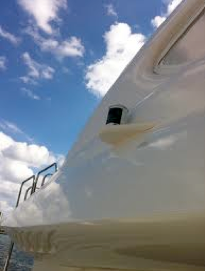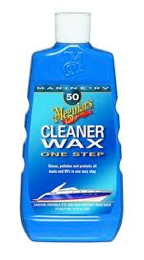By Richard Strauss, Broker with Galati Yacht Sales

An effective care and maintenance program should be implemented from the beginning to maintain the overall appearance and value of your vessels gel coat. Consider that your boat’s gel coat is exposed to salt, dirt, pollution, soot, and exhaust on a daily basis. In addition to the destructiveness of forces of these elements is the sun. Removing them by weekly washing will prevent attack and breakdown of the finish, reducing gloss and reduced overall appearance. Additionally, valuable time is lost because it is more difficult to clean a damaged surface. In addition to a good weekly washing using the proper soap, it is wise to thoroughly rinse your boat with clean fresh water after each use. Employing the extra pressure of using a pressure washer at least once a month helps in forcing out trapped dirt and salt deposits in tight areas, around deck hardware and rub rails.
Cleaning your Gel Coat
When washing your boat use products designed for gel coat, not house hold products like Sno- Bol® and Soft Scrub® as they scratch as they clean. Also, if using a brush make sure it is a soft bristled brush designed for use on gel coat or painted surfaces. Tiny scratches will speed oxidation and dull your boat’s gel coat quickly. Once a boat oxidizes, the hull is vulnerable to greater damage from water penetration. Additionally, house cleaning products like toilet bowel cleaners are very harsh and tend to break down the oils in the gel coat which is a petroleum base, thus speeding up the aging process of gel coat. If your boats gel coat has been well maintained and is waxed regularly, you may want to use a boat soap that has wax in it to help maintain the shine and life of the applied wax.
After washing your boat dry it off with a chamois to remove water spots after washing or use an in-line water softener such as Wet Spot® http://www.softwetspot.com/ or Yacht-Mate http://www.yachtmate.com/ .
Protecting your Gel coat
Not all waxes are created equal, and there is a reason for this. The condition of your gel coat will determine the right wax for you. If your gel coast is new and/or in excellent condition (no micro scratches, dull spots and/or oxidation then use a high quality beeswax, carnuba or silicon based wax. If you have  some oxidation you may opt for a cleaner/wax product. Depending on the level of oxidation and/or minor scratches there are different levels of cleaner/waxes. For mild cases a good product is Meguiar’s Cleaner Wax 50® http://www.meguiars.com/ . For more extreme cases you may need to use 3M’s Gel Coat Restorer and Wax® http://tinyurl.com/cce6u25. If using this product, I would recommend going over your boat again with a high quality Premium Liquid Paste Wax in addition to the 3M Gel coat Restorer and Wax for extra UV protection. For a quick refresher, there are spray waxes or quick waxes. These are good to use between regularly scheduled waxings to keep up the shine while removing light dirt and water spots. Check out Meguiar’s Quik Wax 59® or Lucas Slick Mist® http://taek.me/66739 . These two products are easy to use and can be applied to painted, gel coat or powder coated surfaces as well as stainless hardware.
some oxidation you may opt for a cleaner/wax product. Depending on the level of oxidation and/or minor scratches there are different levels of cleaner/waxes. For mild cases a good product is Meguiar’s Cleaner Wax 50® http://www.meguiars.com/ . For more extreme cases you may need to use 3M’s Gel Coat Restorer and Wax® http://tinyurl.com/cce6u25. If using this product, I would recommend going over your boat again with a high quality Premium Liquid Paste Wax in addition to the 3M Gel coat Restorer and Wax for extra UV protection. For a quick refresher, there are spray waxes or quick waxes. These are good to use between regularly scheduled waxings to keep up the shine while removing light dirt and water spots. Check out Meguiar’s Quik Wax 59® or Lucas Slick Mist® http://taek.me/66739 . These two products are easy to use and can be applied to painted, gel coat or powder coated surfaces as well as stainless hardware.
Frequency of waxing your boat depends on where you live. The minimum recommended waxing frequency is twice per year. If you live in South Florida, as many of us do, the sun’s intensity is a lot higher (more UV). So, it stands to reason that 3 or 4 times per year is not out of the question.
Richard Strauss is a broker with Galati Yacht Sales, and has been around boats nearly all his life. He has a degree in Marine Technology from Florida Tech, and has worked for well-known boat manufacturers as well as operated his own boat repair facility for fourteen years. When he is not busy helping customers find the boat of their dreams or sell their existing boat, he can be found cruising the waters of Sarasota Bay. You can contact Richard at https://www.linkedin.com/in/richard-strauss-82425926 or 239-633-5724.
